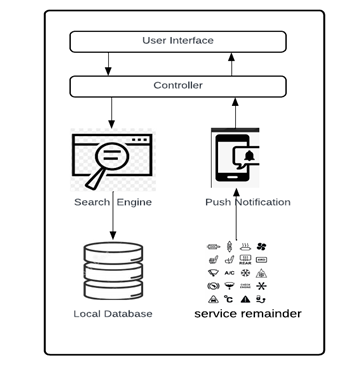Abstract:
The user manual that comes with a newly purchased vehicle can be overwhelming for drivers, as it contains a large amount of information and is often presented in a language that may not be their first language. Despite the importance of this information for the proper maintenance and operation of the vehicle, many drivers may not read the manual or struggle to recall relevant information when needed.
To address this issue, we propose a mobile application that provides drivers with a user-friendly interface to access vehicle maintenance and MIL diagnostics information. The app will be designed to be easily searchable, making it quick and convenient for drivers to find the information they need. We understand that language can be a barrier for some drivers, which is why we will also support vernacular languages to make the app accessible to a wider audience.
Our goal is to ensure that drivers have the necessary information to properly maintain and operate their vehicles, promoting safety and preventing potential breakdowns. By offering this information in a convenient and accessible format, we believe that we can help to improve the overall driving experience for vehicle owners.
Keywords: #Cluster Lamps, #CEL, #MIL, #Water In Fuel lamp, #vehicle breakdown, #vehicle safety
Introduction:
A paper-based user manual is a traditional approach to providing information to users about a product, including vehicles. It usually consists of a printed booklet that contains detailed information about the vehicle, including its features, functions, and maintenance instructions. However, this method has several disadvantages.
Firstly, paper-based manuals are often lengthy and difficult to navigate. Users may have trouble finding the information they need, leading to frustration and potential errors. Additionally, the information provided may become outdated as the vehicle ages or as updates are made, requiring users to refer to multiple sources for accurate information.
Secondly, paper-based manuals are not always available when needed. Drivers may forget to bring the manual with them on long trips or may lose it altogether, leaving them without important information about their vehicle especially when malfunction indicator lamp (MIL) is switched ON. In such cases, it becomes difficult for drivers to troubleshoot any issues that may arise during their journey.
Thirdly, paper-based manuals are not environmentally friendly. The printing and distribution of manuals require large amounts of paper, contributing to deforestation and carbon emissions. As the world becomes more conscious about environmental issues, this approach is no longer acceptable.
To address these issues, a new approach is needed, which is where digital solutions such as mobile apps come in.
Proposed Solution:
The Android app for vehicle driver user manual is designed to provide drivers with a user-friendly interface to access important information related to their vehicle’s maintenance and MIL diagnostics. The app includes a search feature that allows drivers to quickly find the information they need, as well as multi-language support, making it accessible to a wider range of drivers.
The app incorporates an intuitive UI design, making it visually appealing and easy to navigate. The main menu of the app includes different categories, such as engine, transmission, brakes, and electrical, which contain information specific to each category. The app also includes a glossary of technical terms, providing drivers with easy-to-understand explanations of industry-specific jargon.
For the offline model, search functionality can be implemented using a local database within the mobile app. This can be achieved by creating a local database with all the required data and configuring the search feature to search through this database. When the user enters a search query, the app will query the local database and return the relevant results to the user.
Push notifications can also be implemented in an offline model using a combination of local storage and background services. The app can use local storage to store push notifications that are received while the app is offline. When the app is opened again, the stored notifications can be displayed to the user. Additionally, the app can use background services to periodically check for new push notifications even when the app is not actively running. This can be done by setting up a background task to periodically query the server for new notifications and store them locally on the device. When the user opens the app, the stored notifications can be displayed to the user.
The Search Engine and Push Notification components are responsible for implementing the search and notification features, respectively. These components may use external libraries or APIs to provide their functionality.
The Network Services component handles communication with external servers or services, such as the remote monitoring system for electrified cars. The Local Database/Storage component manages local storage on the device, such as caching data for offline use.
Together, these components work together to provide a seamless user experience and reliable functionality for real-time vehicle monitoring and fault detection.
Overall, the Android app for vehicle driver user manual provides drivers with a comprehensive and accessible source of information, improving their understanding of their vehicle and enabling them to make informed decisions related to maintenance and repair.
Fig 1: System architecture

Conclusion and Future work:
Mobile application that provides information about vehicle malfunctions, DTCs and maintenance information etc. can be a valuable tool for Vehicle owners. The proposed solution can offer benefits to both users and the industry, improving the overall driving experience and increasing customer satisfaction. It is crucial to keep up with advancements in technology and continue to develop innovative solutions that address the evolving needs of the automotive industry. Future enhancements of the system include reading real-time vehicle data and DTCs from telematics system and providing guidance for resolving the issue. Augmented Reality (AR) can be used to make information more interactive for drivers.
